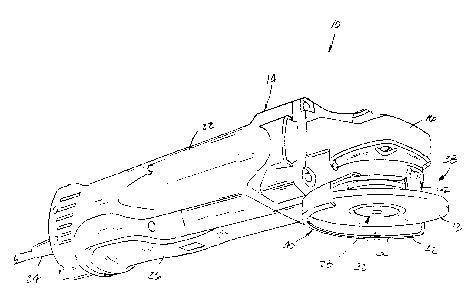Some of the information on this Web page has been provided by external sources. The Government of Canada is not responsible for the accuracy, reliability or currency of the information supplied by external sources. Users wishing to rely upon this information should consult directly with the source of the information. Content provided by external sources is not subject to official languages, privacy and accessibility requirements.
Any discrepancies in the text and image of the Claims and Abstract are due to differing posting times. Text of the Claims and Abstract are posted:
| (12) Patent Application: | (11) CA 2176428 |
|---|---|
| (54) English Title: | ADJUSTABLE GUARD ARRANGEMENT FOR POWER TOOL |
| (54) French Title: | PROTECTION REGLABLE POUR OUTIL MECANIQUE |
| Status: | Deemed Abandoned and Beyond the Period of Reinstatement - Pending Response to Notice of Disregarded Communication |
| (51) International Patent Classification (IPC): |
|
|---|---|
| (72) Inventors : |
|
| (73) Owners : |
|
| (71) Applicants : |
|
| (74) Agent: | MACRAE & CO. |
| (74) Associate agent: | |
| (45) Issued: | |
| (22) Filed Date: | 1996-05-13 |
| (41) Open to Public Inspection: | 1996-12-29 |
| Examination requested: | 1999-06-11 |
| Availability of licence: | N/A |
| Dedicated to the Public: | N/A |
| (25) Language of filing: | English |
| Patent Cooperation Treaty (PCT): | No |
|---|
| (30) Application Priority Data: | ||||||
|---|---|---|---|---|---|---|
|
The invention provides a guard arrangement
including a guard member having an annular base
provided with axially spaced apart first and second
sets of radially inwardly extending and
circumferentially spaced apart projections. The first
and second sets of projections are circumferentially
aligned and are alignable with axially extending
grooves on a tool housing so that the guard member can
be slid or snapped on and off the tool housing. To
lock the guard member against removal from the tool
housing, the tool housing is provided with a pair of
annular grooves for receiving the projections on the
guard member when the guard member is angularly shifted
from a mounting position. To lock the guard member in
a desired angular position, the guard member is
provided with a finger-operated locking member that is
engageable with detents located on the tool housing.
Note: Claims are shown in the official language in which they were submitted.
Note: Descriptions are shown in the official language in which they were submitted.

2024-08-01:As part of the Next Generation Patents (NGP) transition, the Canadian Patents Database (CPD) now contains a more detailed Event History, which replicates the Event Log of our new back-office solution.
Please note that "Inactive:" events refers to events no longer in use in our new back-office solution.
For a clearer understanding of the status of the application/patent presented on this page, the site Disclaimer , as well as the definitions for Patent , Event History , Maintenance Fee and Payment History should be consulted.
| Description | Date |
|---|---|
| Inactive: IPC from MCD | 2006-03-12 |
| Inactive: IPC from MCD | 2006-03-12 |
| Inactive: IPC from MCD | 2006-03-12 |
| Application Not Reinstated by Deadline | 2004-03-19 |
| Inactive: Dead - No reply to s.30(2) Rules requisition | 2004-03-19 |
| Inactive: Abandoned - No reply to s.30(2) Rules requisition | 2003-03-19 |
| Inactive: S.30(2) Rules - Examiner requisition | 2002-09-19 |
| Letter Sent | 1999-07-05 |
| Inactive: Status info is complete as of Log entry date | 1999-07-05 |
| Inactive: Application prosecuted on TS as of Log entry date | 1999-07-05 |
| Request for Examination Requirements Determined Compliant | 1999-06-11 |
| All Requirements for Examination Determined Compliant | 1999-06-11 |
| Application Published (Open to Public Inspection) | 1996-12-29 |
There is no abandonment history.
The last payment was received on 2003-04-22
Note : If the full payment has not been received on or before the date indicated, a further fee may be required which may be one of the following
Patent fees are adjusted on the 1st of January every year. The amounts above are the current amounts if received by December 31 of the current year.
Please refer to the CIPO
Patent Fees
web page to see all current fee amounts.
| Fee Type | Anniversary Year | Due Date | Paid Date |
|---|---|---|---|
| MF (application, 2nd anniv.) - standard | 02 | 1998-05-13 | 1998-04-09 |
| MF (application, 3rd anniv.) - standard | 03 | 1999-05-13 | 1999-03-18 |
| Request for examination - standard | 1999-06-11 | ||
| MF (application, 4th anniv.) - standard | 04 | 2000-05-15 | 2000-04-18 |
| MF (application, 5th anniv.) - standard | 05 | 2001-05-14 | 2001-03-26 |
| MF (application, 6th anniv.) - standard | 06 | 2002-05-13 | 2002-03-28 |
| MF (application, 7th anniv.) - standard | 07 | 2003-05-13 | 2003-04-22 |
Note: Records showing the ownership history in alphabetical order.
| Current Owners on Record |
|---|
| MILWAUKEE ELECTRIC TOOL CORPORATION |
| Past Owners on Record |
|---|
| CHUNGKIN YEE |